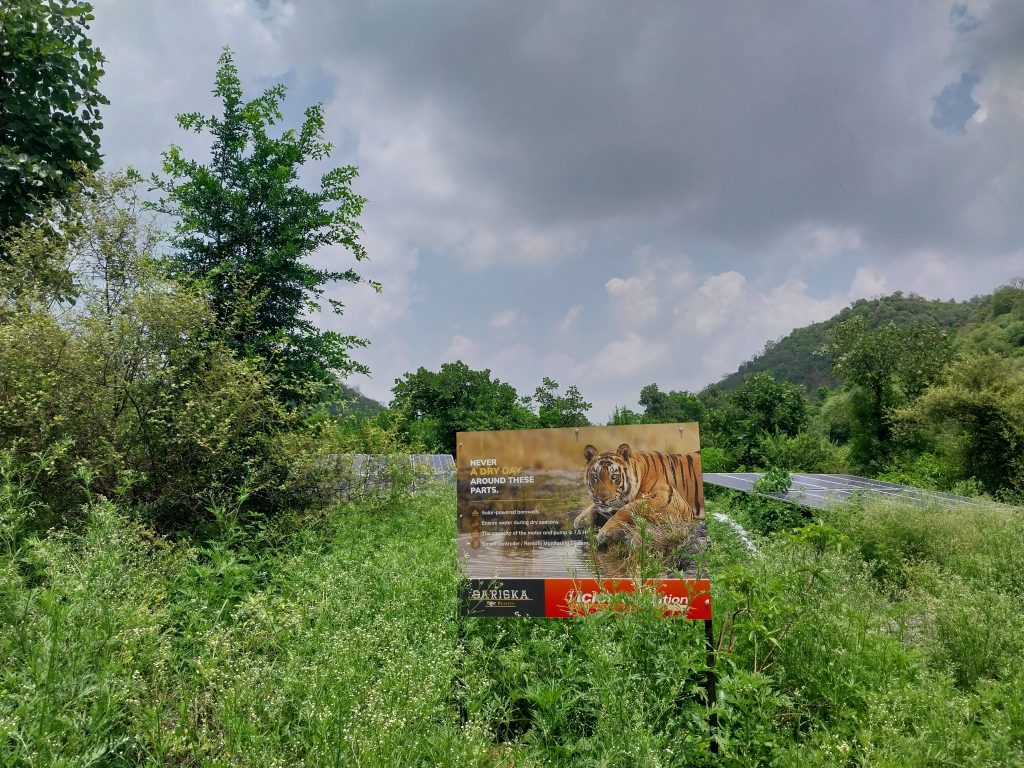
The idea of rewilding is to revive landscapes that have lost their historic faunal diversity and numbers due to various factors, writes Deepanwita Gita Niyogi
As the camper vehicle screeched to a halt near a solar-powered water pump system in the Sariska Tiger Reserve in Rajasthan’s Alwar district, the wilderness of the surroundings caught the eye.
The national park, which lies close to Delhi, lost its tigers in 2004-2005. As part of the reintroduction plan, two animals were brought from the Ranthambore Tiger Reserve in 2008. Today, Sariska supports about 30 tigers.
To ensure that tigers and other wildlife flourish in Sariska, the park management concentrated on rewilding, an attempt made to naturalise an area. This was carried out in the Talvrisksh range of the park. Guides informed this has helped in increasing the movement of tigers. In the peak summer months, water holes ensure that there is never a dry day for the animals.
Around May this year, two bears were also reintroduced in Sariska from Mount Abu as the area historically had the presence of bears, said Sariska National Park deputy director DP Jagawat at his office.
Talking about the rewilding attempt, the officer informed that there was immense pressure on the forest area in the Talvriksh range due to the presence of cattle. “After rewilding, the forest quality has improved which was in a degraded condition before. The number of herbivores increased as their competition with cattle decreased. Now, grass will also be introduced even though many trees flourished on their own after two villages were shifted out.”
Restoring landscapes
According to Jharkhand-based wildlife conservationist Raza Kazmi, the idea of rewilding is to restore landscapes that have lost their historic faunal diversity and numbers due to various factors. In the case of tiger conservation, it means restocking forests with prey animals that might have declined or gone locally extinct in the recent past.
Even places without tigers have been rewilded and the best example in this case is Uttarakhand where a mini forest has been created in Kalsi near Dehradun. According to forest officer Sanjiv Chaturvedi, who planned this entire exercise, it was carried out on an experimental basis. “Now that it has been successful, it can serve as an example elsewhere in the country to both governmental as well as non-governmental players,” said Chaturvedi, who is posted as the chief conservator of forests (research) in Haldwani, Nainital.
The Kalsi forest area was covered with lantana, an obnoxious weed, which is difficult to control. In 2020, work started on the eradication of the weed and the introduction of native species of trees and shrubs on one hectare of land. Now, there are about 9000 trees and plants, many of which are fruiting and flowering. More than 70 native species have been introduced here which will take care of carbon sequestration and biomass.
Chaturvedi added that the Kalsi model may not be the only way forward as there can be other options too. He also spoke about efforts to eradicate another weed in Uttarakhand by replacing it with bamboo and native grass species.
Just like Sariska where tiger movement has increased post rewilding, in Kalsi certain bird species are now spotted often after the rehabilitation attempt which is showing results in just three years.
Defining rewilding
According to Jayant Kulkarni, executive director of Pune-based non-profit Wildlife Research and Conservation Society, sometimes the terms rewilding and reforestation are used in a similar fashion. However, Kulkarni informed that rewilding is a more natural phenomenon as part of which an entire ecosystem is considered. “In the West, rewilding is being promoted on large areas of land. It can be done anywhere, in a tiger reserve and also away from it. Rewilding restores an area to a natural habitat after human interference and presence has been removed.”

In Europe, the Greater Côa Valley found in northeastern Portugal and encompassing the border region between Portugal and Spain from the Douro river in the north to the Malcata Mountains in the south, has been taken up for rewilding, according to the website of Rewilding Portugal, a non-profit.
Coming back to India, Chaturvedi informed that the Kalsi model has elements of rewilding, reforestation, afforestation and rehabilitation. “The native species had an important role to play here and it wasn’t merely a plantation effort. After lantana was removed, local tree and plant species flourished.”
As rewilding happens before tigers are introduced, the Satkosia Tiger Reserve management in Odisha, which is planning to reintroduce tigers possibly by next year, is working towards ensuring a healthy prey base for the tiger by developing meadows. The reserve has no tiger at present but a viable leopard population. A few villages will also be relocated in the process.












